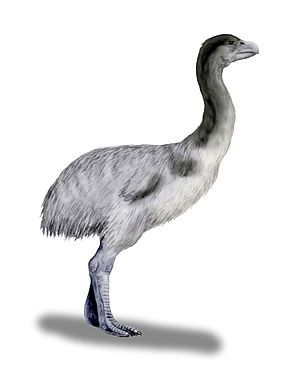Newton's mihirung facts for kids
Quick facts for kids GenyornisTemporal range: Late Pleistocene
|
|
|---|---|
 |
|
| Scientific classification | |
| Genus: |
Genyornis
|
| Species: |
newtoni
|
Genyornis newtoni was a giant, flightless bird that once roamed Australia. Standing over two meters tall, these amazing birds likely ate either plants or a mix of plants and animals. They disappeared about 30,000 years ago. Many other large animals in Australia also became extinct around the same time. This period matches when humans first arrived on the continent. Their closest living relatives today are fowl, like chickens and turkeys.
Contents
About Genyornis Birds
Genyornis newtoni was a very large bird, much bigger than any bird alive today. It could not fly, similar to modern ostriches or emus. Scientists believe these birds were either omnivores (eating both plants and meat) or herbivores (eating only plants). They lived during the Late Pleistocene epoch, a time when many giant animals roamed the Earth.
Why Did Genyornis Disappear?
Scientists have two main ideas about why large animals, like Genyornis, became extinct. One idea is that humans caused their disappearance. The other is that changes in the climate were to blame.
Evidence from Eggshells
Researchers studied over 700 pieces of Genyornis eggshells. They used dating methods to find out how old these eggshells were. The results showed that Genyornis numbers dropped quickly and they became extinct over a short time. This period was too short to be easily explained by natural climate changes. This suggests that human activities might have caused the mass extinction event in Australia.
A different study in 2015 looked at Genyornis eggshell pieces from about 200 different places. Many of these eggshells had burn marks on them. Scientists used a special test called amino acid analysis on the eggshells. This test showed that the eggs were likely cooked over an open fire. The eggshells were dated to between 53,900 and 43,400 years ago. This suggests that early humans were collecting and cooking Genyornis eggs for thousands of years before the birds died out. However, a later study suggested that these eggs might have belonged to a different extinct bird, the giant malleefowl.
Genyornis in Ancient Art
In May 2010, archaeologists found an old Aboriginal rock art painting. This painting might be as old as 40,000 years. It was found at the Nawarla Gabarnmung rock art site in the Northern Territory of Australia. The painting shows two birds in great detail. Many believe these birds are Genyornis. This artwork could mean that Genyornis lived alongside humans for a long time. Some recent ideas also suggest that Genyornis might have survived longer in parts of Victoria, based on old Aboriginal stories.
See also
 In Spanish: Genyornis newtoni para niños
In Spanish: Genyornis newtoni para niños

